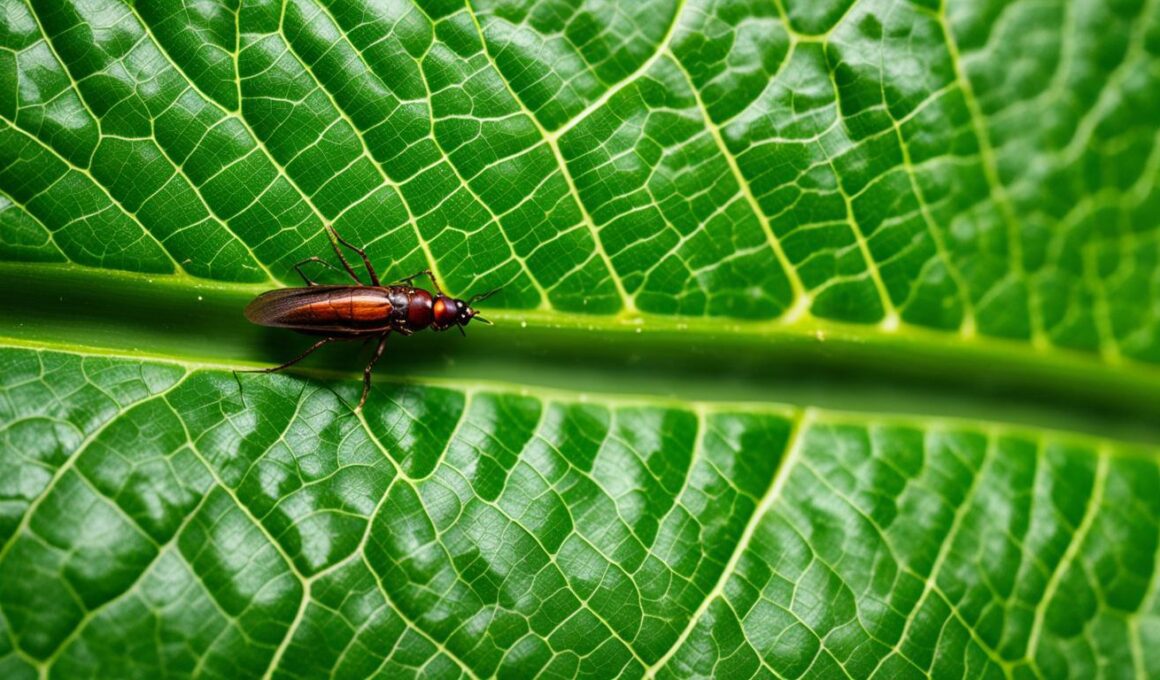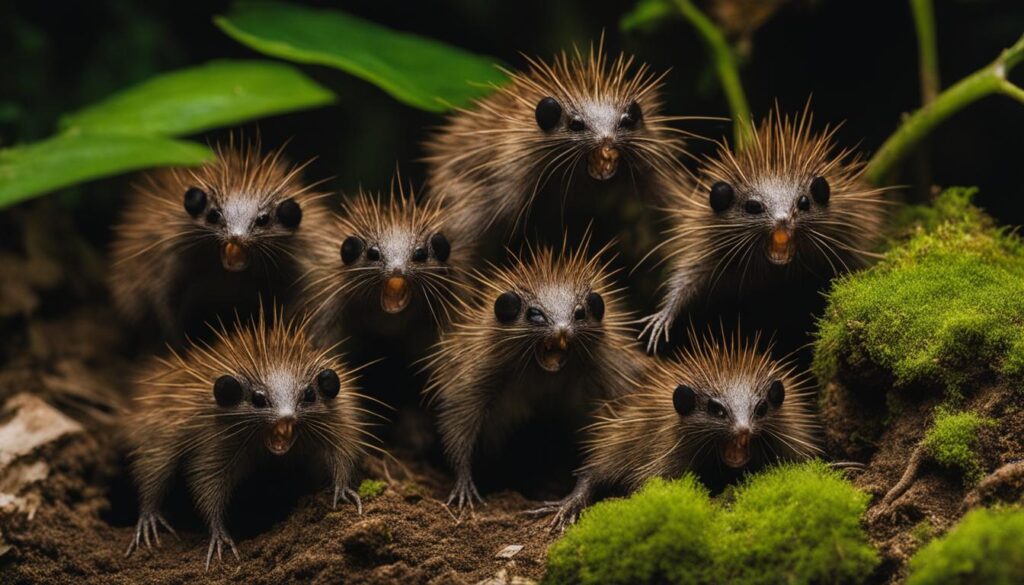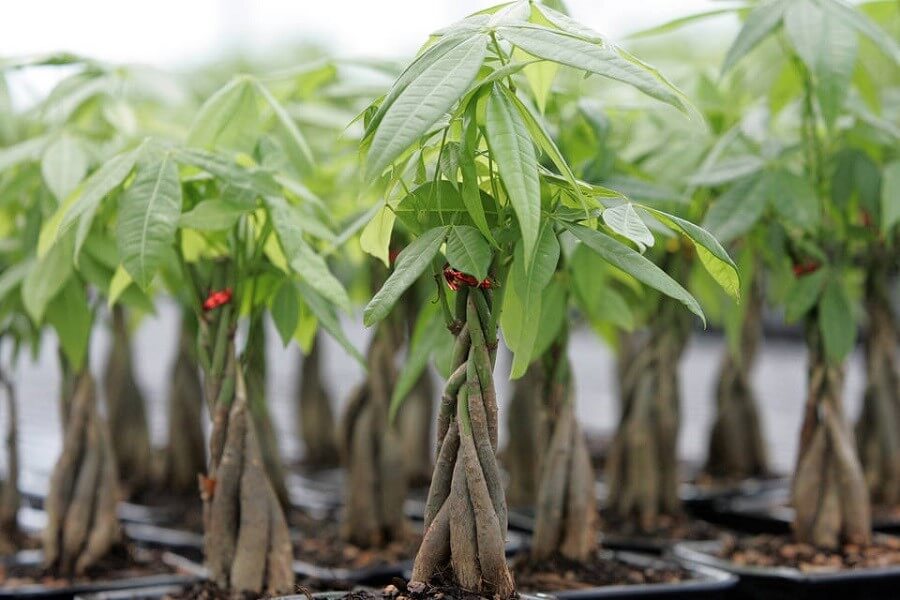Welcome to our informative article on leaf miners, a common garden pest that can cause significant damage to your plants. Leaf miners are tiny insects that burrow through leaves, leaving behind distinctive trails that resemble intricate mazes. These pesky critters primarily attack herbaceous plants but can also target trees and shrubs, creating unsightly holes and damage in the process.
Curious to know more about leaf miners? Read on as we delve into identifying these pests, the impact they have on plants, and how you can protect your garden from their leaf-munching activities.
Key Takeaways:
- Leaf miners are small insects that burrow through leaves, leaving behind distinctive trails.
- They primarily attack herbaceous plants but can also target trees and shrubs.
- Leaf miner damage includes unsightly holes and chewed-up foliage.
- Identifying leaf miners is possible through their small size and the trails they create on leaves.
- Protecting your garden from leaf miners requires proactive pest management strategies.
Identifying Leaf Miners
Leaf miners create distinctive trails and mazes on leaves as they burrow through, leaving behind a mess of chewed up foliage. These trails are a clear sign of leaf miner infestation. Leaf miners can be identified by their small size and the trails they create on leaves. They belong to various insect families such as flies, moths, and beetles. Leaf miner infestations can have a significant impact on the health and appearance of plants.
When inspecting your plants for leaf miners, look for winding trails that follow the veins of the leaves. These trails may be white, brown, or discolored, depending on the species of leaf miner. You may also notice small puncture holes or blotches on the leaves where the adult leaf miners have laid their eggs.
To get a closer look at the leaf miner trails, use a magnifying glass or a hand lens. This will help you see the intricate patterns created by the leaf miners as they feed and move through the leaves. By identifying leaf miners early on, you can take steps to prevent further damage to your plants.
The Impact of Leaf Miners
Leaf miners are a common garden pest that can have a significant impact on the health and appearance of your plants. With over 3,000 species worldwide, these tiny insects feed on the interior tissues of leaves, creating distinctive trails that wind like intricate mazes across foliage surfaces. Their feeding habits can weaken the foliage, making it vulnerable to other pests and diseases.
Leaf miners primarily attack herbaceous plants, but they can also target trees and shrubs. The damage they cause can be unsightly, leaving behind chewed up leaves with holes and trails. This not only affects the aesthetic appeal of your garden but also compromises the overall health of your plants.
The worldwide scope of leaf miners means that they can be found in gardens all around the globe. As a gardener, it’s important to be vigilant against these pests and take preventive measures to protect your plants. By identifying leaf miner infestations early on and implementing effective pest management strategies, you can minimize the damage caused by these pesky insects and ensure the health and vitality of your garden.
Other Culprits: Root Nibblers
While leaf miners are busy causing damage aboveground, there are also pests hiding beneath the soil that can nibble away at plant roots. These root nibblers include nematodes, wireworms, and grubs.
Nematodes are microscopic roundworms that feed on plant roots, causing wilted foliage. They can be difficult to detect as they are invisible to the naked eye, but their impact on plants can be devastating.
Wireworms, on the other hand, are slim elongated larvae of click beetles that gnaw on underground stems and tubers. These pests can cause significant damage to the root systems of plants, leading to stunted growth and poor overall health.
Last but not least, grubs are the larval stage of various beetles and are known to chew through roots. These fat, cream-colored pests can wreak havoc on your garden if left unchecked.
Protecting Your Plants
To protect your plants from root nibblers, it’s important to take preventive measures. One approach is to ensure proper soil drainage, as excessive moisture can attract nematodes and provide an ideal environment for their reproduction. Additionally, rotating crops and practicing good sanitation in the garden can help disrupt the life cycles of wireworms and grubs.
Using beneficial nematodes, which are natural predators of plant-damaging nematodes, can also be an effective biological control method. These microscopic organisms can be introduced to the soil to help keep nematode populations in check. Likewise, introducing predatory insects, such as ground beetles, can help control wireworm and grub populations.
By implementing these preventive measures and staying vigilant, you can protect your plants from the hidden threats posed by root nibblers.
Sneaky Slugs and Slimy Snails
Slugs and snails are two slimy pests that can wreak havoc on your garden, causing damage to your plants. These notorious nibblers leave behind large irregular-shaped holes on leaves, which can significantly impact the health and appearance of your foliage.
Slugs, with their soft bodies and lack of shells, are particularly adept at plant devouring. They tend to favor young foliage, where chewing is less strenuous for them. Snails, on the other hand, are close cousins to slugs but have a protective shell they call home. Both slugs and snails are highly skilled at finding and feasting on plants, leaving a slimy trail of destruction in their wake.
To protect your garden from these slimy pests, there are a few measures you can take. One option is to create physical barriers that slugs and snails cannot cross. You can use materials like copper tape or diatomaceous earth to create a barrier around your plants. These substances are unpleasant for slugs and snails to crawl over, deterring them from reaching your precious foliage.
Another approach is to use natural remedies to repel slugs and snails. Coffee grounds, crushed eggshells, or even beer traps can be effective deterrents. The caffeine in coffee grounds, the sharp edges of crushed eggshells, and the allure of beer can all discourage slugs and snails from feasting on your plants. By implementing these strategies, you can help protect your garden from these slimy invaders and maintain the beauty of your foliage.
Larger Pests: Deer, Rabbits & Other Wildlife
While insects may be responsible for some of the holes in plant leaves, larger creatures like deer, rabbits, and other wildlife can also be culprits. These wildlife pests can cause significant damage to your garden if left unchecked.
Deer are graceful yet dexterous grazers that visit gardens under cover of darkness, feeding on young shoots and tender leaves. Their voracious appetites can quickly decimate your plants, leaving behind a trail of destruction.
Rabbits, on the other hand, are quick-footed bundles of fur that are highly adept at munching through gardens when given the chance. With their sharp teeth and insatiable hunger, they can make quick work of your carefully cultivated plants.
Protecting your garden from these wildlife pests requires proactive measures. Installing physical barriers such as fences or netting can help keep deer and rabbits out of your garden. Additionally, using motion-activated deterrents or spraying natural repellents can further discourage these pests from invading your green haven.
Safeguarding Your Garden from Wildlife Pests
- Install a sturdy fence or netting around your garden to keep deer and rabbits out.
- Consider using motion-activated deterrents, such as sprinklers or noise devices, to startle and discourage wildlife from entering your garden.
- Use natural repellents made from ingredients like garlic, hot pepper, or predator urine to create an unpleasant environment for pests.
- Regularly inspect your garden for signs of wildlife activity, such as tracks or droppings. This will allow you to take prompt action if any pests are detected.
By taking these preventive measures, you can safeguard your garden from the munching escapades of deer, rabbits, and other wildlife pests. By creating an inhospitable environment and implementing effective deterrents, you can enjoy the beauty and productivity of your garden without sacrificing it to hungry visitors.
How Can Leaf Miners Impact Worm Harvesting Success?
Leaf miners can impact successful worm harvesting secrets by disrupting the leaves that worms feed on. If the leaves become damaged or compromised by leaf miners, it can negatively affect the quality and quantity of the worms that can be harvested. Careful monitoring and management of leaf miners is crucial for successful worm harvesting secrets.
Conclusion
The presence of pests like leaf miners, root nibblers, slugs, snails, deer, rabbits, and other wildlife can pose a threat to your garden. It is crucial to take preventive measures and implement effective pest management strategies to protect your plants.
Become familiar with the culprits responsible for the damage in your garden. Identify leaf miners by their distinctive trails and mazes on leaves. Stay vigilant and take action against root nibblers like nematodes, wireworms, and grubs that hide beneath the soil.
When it comes to slimy pests, such as slugs and snails, be proactive in keeping their populations in check. Consider installing barriers, using natural remedies, and employing physical deterrents. These methods can help protect your beloved plants from their voracious appetites.
Don’t forget about larger pests like deer, rabbits, and other wildlife. These creatures can cause significant damage to your garden. Take measures to protect your plants, whether through fencing, repellents, or other wildlife deterrence techniques.
Incorporating these preventive measures and pest management strategies will help safeguard your garden from leaf-munching invaders. By staying proactive and vigilant, you can create a thriving and pest-free environment for your beloved green haven.
FAQ
What is a leaf miner?
Leaf miners are tiny insects that burrow through leaves, creating distinctive trails that wind like intricate mazes across foliage surfaces.
How can I identify leaf miners?
Leaf miners can be identified by their small size and the trails they create on leaves.
Do leaf miners only attack herbaceous plants?
Leaf miners primarily attack herbaceous plants but can also target trees and shrubs.
What kind of damage do leaf miners cause?
Leaf miners create chewed up leaves, causing unsightly holes and damage to plants.
How many species of leaf miners are there worldwide?
There are over 3,000 species of leaf miners worldwide.
What are root nibblers?
Root nibblers are pests that feed on plant roots, such as nematodes, wireworms, and grubs.
What kind of damage do slugs and snails cause?
Slugs and snails leave behind large irregular-shaped holes on leaves and can cause significant damage to plants.
What other pests can damage my garden?
Other pests include deer, rabbits, and other wildlife that can feed on tender shoots and leaves.
How can I protect my garden from pests?
Preventive measures such as barrier installation, natural remedies, physical deterrents, and attracting beneficial insects can help control pest populations.











